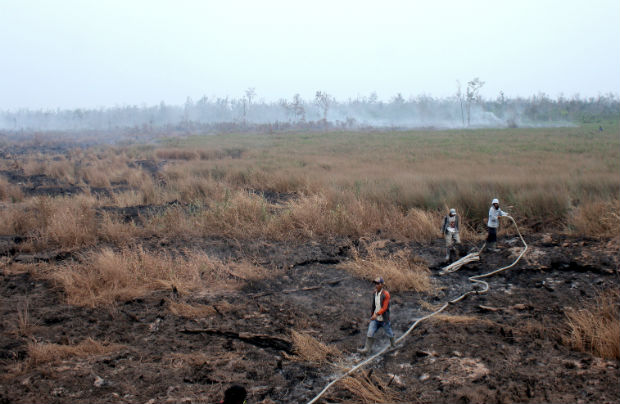Haze victims struggle to remain optimistic

Workers spray water to contain a wildfire that razes through a peat land field in Pedamaran, South Sumatra, Indonesia, Tuesday, Oct. 27, 2015. The haze from forest fires has blanketed parts of western Indonesia for about two months and affected neighboring countries like Singapore, Malaysia and Thailand. AP
Coughing continuously, Akhyar stood at the back of a crowd of people waiting at the registration desk of state-owned Dr. Doris Sylvanus General Hospital (RSUD) in Palangkaraya on Monday afternoon.
The young man, who makes ends meet as a seasonal worker in the neighboring Katingan regency, said he had travelled to the Central Kalimantan provincial capital in the hope of getting treatment for his persistent cough, allegedly triggered by thick haze that has blanketed the province since last month.
Akhyar, however, quickly changed his mind upon seeing the long line of patients with respiratory illnesses at the province’s largest hospital.
“There’s no hope for me to get immediate help here. I will book a flight to Lampung [on Sumatra] today to see my parents and get a medical checkup there,” Akhyar said, adding that he would return to Katingan only when the haze crisis had ended.
Indonesia has been struggling to curb the impacts of air pollution originating from fires in peatland and plantations in Sumatra and Kalimantan for months.
Article continues after this advertisementPalangkaraya, home to 250,000 people, has become the city with the worst air quality in the country, as the concentration of particulate matter (PM10) has stood at extremely dangerous levels for weeks.
Article continues after this advertisementThe Meteorology, Climatology and Geophysics Agency (BMKG) reported on Tuesday that the PM10 concentration in the city stood at 1,696.06 micrograms per cubic meter (μg/m3), the highest nationwide.
Last week, the National Disaster Mitigation Agency (BNPB) reported that the ongoing haze crisis had claimed 10 lives and caused more than 500,000 people, mostly children, in the six worst-hit provinces to suffer from acute respiratory infections.
Of the figure, 52,000 people were from Central Kalimantan.
In Palangkaraya, the huge number of incoming patients has made it difficult for local hospitals and community health centers (Puskesmas) to provide immediate medical assistance for some of the patients.
Last week, RSUD Dr Doris Sylvanus, which has more than 250 beds, for example, temporarily stopped admitting inpatients as all of the hospital’s beds were occupied.
In an attempt to avoid hospital issues, local resident Chandra Wijaya said he and his wife had refrained from taking their 6-month-old baby outdoors in recent weeks to prevent the baby from getting sick.
“We leave the air conditioner on in our bedroom to make our baby comfortable,” Chandra told The Jakarta Post.
Central Kalimantan Health Agency head Suprastija Budi said the local authorities would prepare at least three buildings as evacuation shelters for haze victims.
Meanwhile, in Jambi, where fires have burned more than 15,000 hectares of land since August, local authorities are preparing to convert at least eight buildings into evacuation shelters, including Kotabaru Sports Hall and two convention centers.
In Riau, the country’s largest oil-producing region, a local BMKG station reported on Tuesday that haze had reduced visibility in several cities, including Pekanbaru, Dumai and Pelalawan, to below 800 meters.
In neighboring West Sumatra, eight of the province’s 19 regional administrations on Tuesday decided to close down kindergartens and elementary schools after air quality dropped to dangerous levels.
RELATED STORIES
Aquino: PH won’t castigate Indonesia for haze, to offer help instead